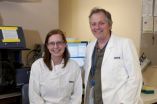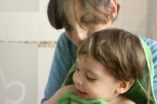(Press-News.org) AURORA, Colo. (Oct. 7, 2010)—In 2006, Dr. Shimya Yaminaka of Kyoto University in Japan set the stem cell and regenerative medicine research world on fire when he successfully transformed differentiated mouse skin cells into cells that looked and behave like embryonic stem cells. Embryonic stem cells, the subject of much controversy when used in research, have the ability to differentiate into any type of tissue.
Yaminaka's creation of induced pluripotent stem cells [iPSCs] meant that in the future, research to improve human disease might be able to use iPSCs in lieu of embryonic stem cells. Since then, researchers around the world have been able to replicate his process. However, no one has been able to unlock the mechanism that allows cells to be regressed from differentiated to undifferentiated cells—until now.
University of Colorado Cancer Center researcher Chuan-Yuan Li, PhD, and his group have discovered that so-called "grim-reaper" caspase genes are the gatekeepers that can open the door to allow differentiated adult cells to regress to undifferentiated iPSCs.
"By doing experiments in which we added caspase inhibitor genes to the Yaminaka protocol, we discovered that when caspases are turned off, you cannot make IPSCs," says Li, professor of radiation oncology at the University of Colorado School of Medicine. "We were able to shut down the process almost completely."
The discovery is the cover article in the Oct. 8, 2010 issue of Cell Stem Cell.
"For practical reasons, the discovery is important because even though the transformation to iPSCs is a straightforward process on surface, it is not very efficient, and this information can help increase efficiency," Li says. "It can also help with the problem of cells that don't complete the transformation process acting like cancer cells. And from a purely scientific perspective, it is fascinating to understand why the magic happens."
Li's group had been working on the roles of caspases in wound healing when Yaminaka published his initial iPSC work in mice. That got Li thinking about potential roles of caspases in iPSC generation.
"I thought maybe caspases could also induce iPS cells instead of the four transcriptional factors that Yamanaka used," he says. "If that was true, it would be very exciting."
For six months, his group tried different experiments using various caspase genes to coax human skin cells into iPS cells, but they had no success. Although caspases were not sufficient to make iPS cells, Li kept going with the idea that caspases were somehow involved.
They made their discovery when they introduced the caspase inhibitors into skin cells, which almost completely shut down the induction of iPS cells.
Caspases, Li says, appear to loosen up the built-in controls that make a cell differentiated or undifferentiated, just like a clutch allows a driver to switch gears while driving. Undifferentiated stem-like cells and differentiated cells from one person have the exact same genes. The difference between them is which genes are turned on or off.
In other words, he says, caspases could be the key to a kind of cellular reincarnation—taking a cell that, during human development, became a skin cell back to its original state to become any kind of cell.
"About twenty years ago, a scientist who was among the first to clone the caspase 3 gene named the gene Yama, the Hindu Lord of Death who was responsible for both killing a being and setting him on his way into his reincarnated life," Li said. "It is now becoming clear that caspases don't just kill, but they can change the cell's fate. They could be a mediator of epigenetic changes in multi-cellular organisms."
###
Members of Li's research group who were integral to the studies include Fang Li, the paper's lead author, Zhimin He, Jingping Shen, Qian Huang, Wenrong Li, Xinjian Liu, Yujun He and Frank Wolf.
About the University of Colorado Cancer Center
The University of Colorado Cancer Center is the Rocky Mountain region's only National Cancer Institute-designated comprehensive cancer center. NCI has given only 40 cancer centers this designation, deeming membership as "the best of the best." Headquartered on the University of Colorado Denver Anschutz Medical Campus, UCCC is a consortium of three state universities (Colorado State University, University of Colorado at Boulder and University of Colorado Denver) and five institutions (The Children's Hospital, Denver Health, Denver VA Medical Center, National Jewish Health and University of Colorado Hospital). Together, our 440+ members are working to ease the cancer burden through cancer care, research, education and prevention and control. Learn more at www.uccc.info.
END
###
Recommendations for the management of postmenopausal vaginal atrophy are published in the December 2010 edition of Climacteric, and are available at www.imsociety.org. Patient education materials are also available.
NOTES TO EDITORS
A webcast of the IMS press briefing for World Menopause Day will be available from
Monday 11th October at www.imsociety.org.
About the IMS
The International Menopause Society (IMS) was established in 1978 and was the first menopause society in the world. At the time, it signalled to the medical community that there was a need ...
A discovery by Walter and Eliza Hall Institute researchers in Melbourne, Australia, reported in today's edition of Science, is set to rewrite a long-held belief about how the body's immune system establishes its memory.
The findings of Dr Ingela Vikstrom and Associate Professor David Tarlinton, from the institute's Immunology division, centre on immune cells called B cells that produce the antibodies which fight infection.
"B cells and antibody production are the key to the success of all currently used vaccines for
immunity in humans," said Associate Professor Tarlinton. ...
"We found a significant relationship between bacterial infections and acute asthma attacks - above and beyond the expected relationship between viral infections and attacks," says Hans Bisgaard, a professor of paediatrics at the DPAC.
The study examined 361 children between the ages of four weeks and three years to determine the presence of viral and bacterial infections during severe asthma attacks. The results conclude that the number of attacks was just as high in children with bacterial respiratory infections as in those with viral infections.
Using antibiotics ...
Common frog (Rana temporaria) populations across the UK are suffering dramatic population crashes due to infection from the emerging disease Ranavirus, reveals research published in the Zoological Society of London's (ZSL) journal Animal Conservation.
Using data collected from the public by the Frog Mortality Project and Froglife, scientists from ZSL found that, on average, infected frog populations experienced an 81 per cent decline in adult frogs over a 12 year period.
"Our findings show that Ranavirus not only causes one-off mass-mortality events, but is also responsible ...
Large-scale crop failures like the one that caused the recent Russian wheat crisis are likely to become more common under climate change due to an increased frequency of extreme weather events, a new study shows.
However, the worst effects of these events on agriculture could be mitigated by improved farming and the development of new crops, according to the research by the University of Leeds, the Met Office Hadley Centre and University of Exeter.
The unpredictability of the weather is one of the biggest challenges faced by farmers struggling to adapt to a changing ...
Researchers from the Polytechnic University of Cartagena (UPCT) estimate that each pack of cigarettes really costs €107 for men and €75 for women, when premature death is taken into account. These figures confirm previous studies, and are of key importance in the cost-benefit analysis of smoking-prevention policies.
"One of the conclusions of the article is that the price one pays for each pack of cigarettes at a newsstand is only a very small price of the true price that smokers pay for their habit", Ángel López Nicolás, co-author of the study that has been published ...
Researchers from the University of Alicante (UA) taking part in the European VACSATC project have studied mothers' and fathers' opinions on vaccinating their children in five countries. The results of the survey show that Spanish mothers are more resistant than those in other countries to the idea of paying for vaccines, while 20.9% expressed some concern about the safety of vaccines.
"Mothers in Spain are more concerned about vaccinating their children since the incident with the human papilloma virus (HPV) vaccine", José Tuells, a researcher at the UA and a Spanish ...
VIDEO:
This animation demonstrates the orbital perturbations to Venus Express caused by the atmospheric drag experienced as the spacecraft skims the atmosphere of Venus. To experience the drag, the spacecraft must...
Click here for more information.
The polar atmosphere of Venus is thinner than expected. How do we know? Because ESA's Venus Express has actually been there. Instead of looking from orbit, Venus Express has flown through the upper reaches of the planet's ...
Many a holiday is ruined by food poisoning, frequently caused by the bacterium Campylobacter jejuni. Although Campylobacter infections are rarely life-threatening they are extremely debilitating and have been linked with the development of Guillain-Barré syndrome, one of the leading causes of non-trauma-induced paralysis worldwide.
Campylobacter jejuni is well adapted to life in the guts of animals and birds, where it is often found in very high levels. However, to infect humans it also needs to be able to survive outside the gut, on the surface of meat that will be ...
Increased global attention and research needs to be given to stroke prevention and the social and economic effects of the condition in developing countries, according to an academic at the University of East Anglia (UEA).
In a paper published in the current issue of the journal Development Policy Review, Prof Peter Lloyd-Sherlock of the School of International Development argues that policy-makers have been slow to recognise the growing scale of the challenge and impacts of stroke in developing countries. He calls for them to prioritise preventative screening and drug ...



